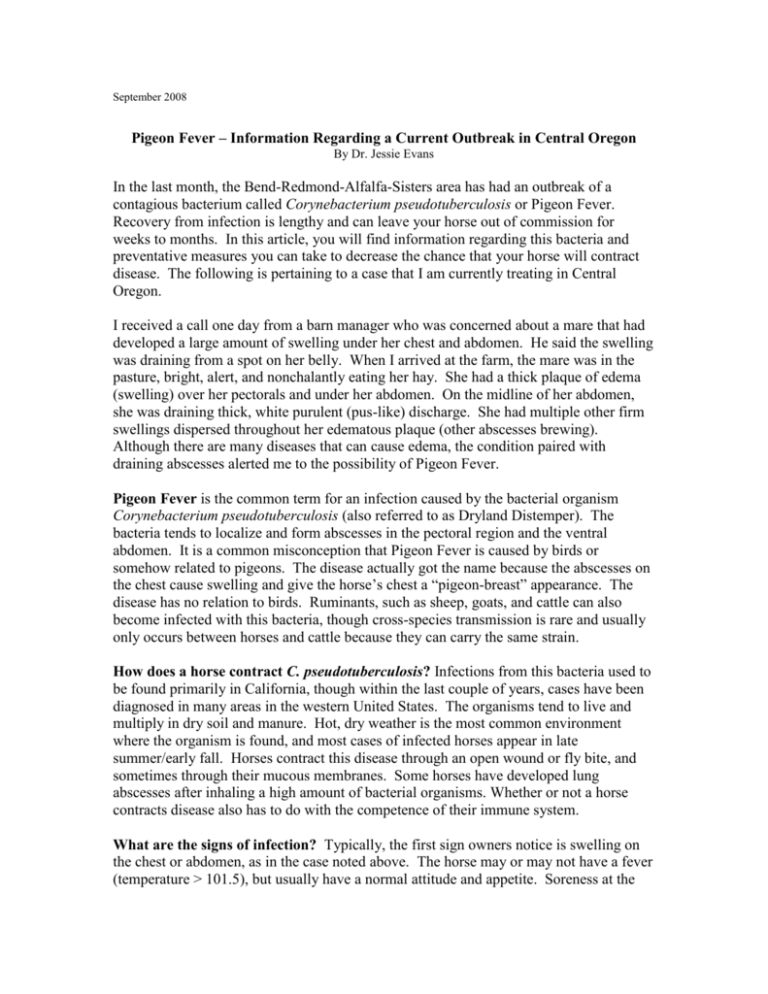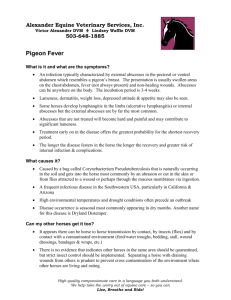Corynebacterium Pseudotuberculosis (Pigeon Fever)
advertisement

September 2008 Pigeon Fever – Information Regarding a Current Outbreak in Central Oregon By Dr. Jessie Evans In the last month, the Bend-Redmond-Alfalfa-Sisters area has had an outbreak of a contagious bacterium called Corynebacterium pseudotuberculosis or Pigeon Fever. Recovery from infection is lengthy and can leave your horse out of commission for weeks to months. In this article, you will find information regarding this bacteria and preventative measures you can take to decrease the chance that your horse will contract disease. The following is pertaining to a case that I am currently treating in Central Oregon. I received a call one day from a barn manager who was concerned about a mare that had developed a large amount of swelling under her chest and abdomen. He said the swelling was draining from a spot on her belly. When I arrived at the farm, the mare was in the pasture, bright, alert, and nonchalantly eating her hay. She had a thick plaque of edema (swelling) over her pectorals and under her abdomen. On the midline of her abdomen, she was draining thick, white purulent (pus-like) discharge. She had multiple other firm swellings dispersed throughout her edematous plaque (other abscesses brewing). Although there are many diseases that can cause edema, the condition paired with draining abscesses alerted me to the possibility of Pigeon Fever. Pigeon Fever is the common term for an infection caused by the bacterial organism Corynebacterium pseudotuberculosis (also referred to as Dryland Distemper). The bacteria tends to localize and form abscesses in the pectoral region and the ventral abdomen. It is a common misconception that Pigeon Fever is caused by birds or somehow related to pigeons. The disease actually got the name because the abscesses on the chest cause swelling and give the horse’s chest a “pigeon-breast” appearance. The disease has no relation to birds. Ruminants, such as sheep, goats, and cattle can also become infected with this bacteria, though cross-species transmission is rare and usually only occurs between horses and cattle because they can carry the same strain. How does a horse contract C. pseudotuberculosis? Infections from this bacteria used to be found primarily in California, though within the last couple of years, cases have been diagnosed in many areas in the western United States. The organisms tend to live and multiply in dry soil and manure. Hot, dry weather is the most common environment where the organism is found, and most cases of infected horses appear in late summer/early fall. Horses contract this disease through an open wound or fly bite, and sometimes through their mucous membranes. Some horses have developed lung abscesses after inhaling a high amount of bacterial organisms. Whether or not a horse contracts disease also has to do with the competence of their immune system. What are the signs of infection? Typically, the first sign owners notice is swelling on the chest or abdomen, as in the case noted above. The horse may or may not have a fever (temperature > 101.5), but usually have a normal attitude and appetite. Soreness at the walk can be seen, usually manifesting secondary to swelling and abscessation on their chest and abdomen. A small percentage of horses can develop internal abscesses, which are more serious. These horses are systemically sick (inappetent, febrile, lethargic, and sometimes colicky). The infection can spread to the horse’s legs as well, causing a syndrome called ulcerative lymphangitis, which is difficult to treat. Definitive diagnosis is achieved by a bacterial culture, though clinical signs can be quite diagnostic. I recommend running bloodwork on these horses to be sure they don’t have overwhelming systemic infection and to monitor their internal organ function. If horses develop internal abscesses, their disease is more serious and could result in damage to their liver or kidneys. Treatment consists mainly of surgically opening the abscesses to allow drainage. The abscesses can be lanced as soon as they are mature. Applying warm compresses to abscesses can help bring them to a head. Your veterinarian can also ultrasound the chest and abdomen to locate deep abscesses and find the best place to drain them. The abscesses should be cleaned and flushed daily with a dilute betadine solution. The use of systemic antibiotics is controversial. Many clinicians believe that antibiotics will delay the maturation of developing abscesses and may facilitate internal abscessation. As long as the horse appears healthy and has a normal attitude and appetite, I prefer to withhold antibiotic therapy. If the abscesses are deep and causing pain and discomfort to the horse, Banamine can be administered. Please consult a veterinarian prior to administering Banamine, though, because overdosing can lead to kidney or gastrointestinal problems in your horse. Prevention and control is important to limit the number of horses affected. Just because one horse is diagnosed does not mean that all horses on your farm will contract disease. Affected horses should be isolated because the drainage from their abscesses contain a high amount bacteria that will contaminate the environment. Flies are a major vector and can spread the bacteria, so you should fly spray both affected and non-affected horses (especially ones with open wounds!). Solitude is a good option for fly control as well. People can carry the bacteria on their shoes, hands, etc., so be sure to maintain good hygiene after handling your sick horse. Bedding, water buckets, and any other material that come in contact with pus should be disinfected/disposed of and not shared with other horses.









